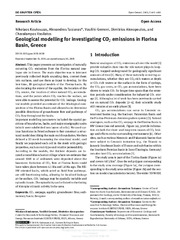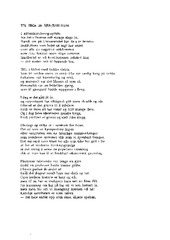Artikler, rapporter og annet (geovitenskap): Recent submissions
Now showing items 781-800 of 825
-
Variability of present and past PAH concentrations in sediments of the SW Barents Sea
(Journal article; Tidsskriftartikkel; Peer reviewed, 2015-10-09)The concentration and distribution of polyaromatic hydrocarbons (PAHs) in surface and subsurface sediment samples from Tromsøflaket and Ingøydjupet, southwestern Barents Sea, were investigated in order to provide insight into the levels and origins of PAHs in a region with petroleum activities. PAH profiles in sediments were evaluated in context with sediment grain size and total organic carbon ... -
Biocryomorphology: integrating microbial processes with ice surface hydrology, topography and roughness
(Journal article; Tidsskriftartikkel; Peer reviewed, 2015-12-02) -
UAV photogrammetry and structure from motion to assess calving dynamics at Store Glacier, a large outlet draining the Greenland ice sheet
(Journal article; Tidsskriftartikkel; Peer reviewed, 2015-01-06)This study presents the application of a costeffective, unmanned aerial vehicle (UAV) to investigate calving dynamics at a major marine-terminating outlet glacier draining the western sector of the Greenland ice sheet. The UAV was flown over Store Glacier on three sorties during summer 2013 and acquired over 2000 overlapping, geotagged images of the calving front at an ∼ 40 cm ground sampling ... -
Seabed morphology and sedimentary processes on high-gradient trough mouth fans offshore Troms, northern Norway
(Journal article; Tidsskriftartikkel; Peer reviewed, 2015-10-01)Trough mouth fans (TMF) situated at the mouths of formerly glaciated cross-shelf troughs are important paleoclimatic archives. Whereas the sedimentary processes of large, low-gradient TMFs have received considerable interest, little attention has been paid to the other end member of this landform class, i.e. TMFs with higher slope gradients. Detailed swath-bathymetric data and seismic profiles from ... -
Microbial methane formation in deep aquifers of a coal-bearing sedimentary basin, Germany
(Journal article; Tidsskriftartikkel; Peer reviewed, 2015-03-20)Coal-bearing sediments are major reservoirs of organic matter potentially available for methanogenic subsurface microbial communities. In this study the specific microbial community inside lignite-bearing sedimentary basin in Germany and its contribution to methanogenic hydrocarbon degradation processes was investigated. The stable isotope signature of methane measured in groundwater and coal-rich ... -
The Miocene-Pliocene boundary and the Messinian Salinity Crisis in the easternmost Mediterranean: Insights from the Hatay Graben (Southern Turkey)
(Journal article; Tidsskriftartikkel; Peer reviewed, 2015-12-02)The Hatay Graben is one of three easternmost basins in the Mediterranean that preserve sediments that span the Miocene–Pliocene boundary, including gypsums from the Messinian Salinity Crisis (MSC). Here we integrate existing data and present new sedimentological and micropalaeontological data to investigate the palaeoenvironments of late Miocene to early Pliocene deposits and place this important ... -
Geological modelling for investigating CO2 emissions in Florina Basin, Greece
(Journal article; Tidsskriftartikkel; Peer reviewed, 2015-10-15)This paper presents an investigation of naturally occurring CO2 emissions from the Florina natural analogue site in Greece. The main objective was to interpret previously collected depth sounding data, convert them into surfaces, and use them as input to develop, for the rst time, 3D geological models of the Florina basin. By also locating the extent of the aquifer, the location of the CO2 ... -
Changing surface–atmosphere energy exchange and refreezing capacity of the lower accumulation area, West Greenland
(Journal article; Tidsskriftartikkel; Peer reviewed, 2015-11-18)We present 5 years (2009–2013) of automatic weather station measurements from the lower accumulation area (1840 m a.s.l. – above sea level) of the Greenland ice sheet in the Kangerlussuaq region. Here, the summers of 2010 and 2012 were both exceptionally warm, but only 2012 resulted in a strongly negative surface mass budget (SMB) and surface meltwater run-off. The observed run-off was ... -
Bivalve shell horizons in seafloor pockmarks of the last glacial-interglacial transition suggest a thousand years of methane emissions in the Arctic Ocean
(Journal article; Tidsskriftartikkel; Peer reviewed, 2015-11-05)We studied discrete bivalve shell horizons in two gravity cores from seafloor pockmarks on the Vestnesa Ridge (1200 m water depth) and western Svalbard (798000 N, 068550 W) to provide insight into the temporal and spatial dynamics of seabed methane seeps. The shell beds, dominated by two genera of the family Vesicomyidae: Phreagena s.l. and Isorropodon sp., were 20–30 cm thick and centered at ... -
Geophysical constraints on the dynamics and retreat of the Barents Sea ice sheet as a palaeobenchmark for models of marine icesheet deglaciation
(Journal article; Tidsskriftartikkel; Peer reviewed, 2015-11-14)Our understanding of processes relating to the retreat of marine-based ice sheets, such as the West Antarctic Ice Sheet and tidewater-terminating glaciers in Greenland today, is still limited. In particular, the role of ice-stream instabilities and oceanographic dynamics in driving their collapse are poorly constrained beyond observational timescales. Over numerous glaciations during the Quaternary, ... -
Controls on gas hydrate system evolution in a region of active fluid flow in the SW Barents Sea
(Journal article; Tidsskriftartikkel, 2015-09)The location and stability of gas hydrates in the SW Barents Sea is poorly constrained due to complex geological, geochemical, and geophysical conditions, including poor controls on regional heat flow and gas chemistry. Understanding the stability of gas hydrates in this region is important, as recent studies suggest destabilizing hydrates may lead to methane discharge into the ocean and possibly ... -
Til IBGs 20-års-jubileum
(Kronikk; Chronicle, 1992) -
Effects of mortality changes on biomass and production in Calanus spp. populations
(Journal article; Tidsskriftartikkel; Peer reviewed, 2011-04-28)Calanus species are the main link between primary producers and higher trophic-level organisms in the Barents Sea. The natural mortality rate is an essential parameter for determining the standing stock of Calanus, but it is also one of the most uncertain parameters in present knowledge. The level of human activity, and the associated risk of pollution, is increasing in the Barents Sea, and knowledge ... -
Asynchronous response of marine-terminating outlet glaciers during deglaciation of the Fennoscandian Ice Sheet
(Journal article; Tidsskriftartikkel; Peer reviewed, 2014-03-31)Recent studies have highlighted the dynamic behavior of marine-terminating outlet glaciers over decadal time scales, linked to both atmospheric and oceanic warming. This helps explain episodes of nearly synchronous fl ow acceleration, thinning, and retreat, but nonclimatic factors such as changes in fjord width and depth, can also induce rapid recession. There is support for these topographic ... -
Optimising the use of marine tephrochronology in the North Atlantic: a detailed investigation of the Faroe Marine Ash Zones II, III and IV
(Journal article; Tidsskriftartikkel; Peer reviewed, 2014) -
A North Atlantic tephrostratigraphical framework for 130–60 ka b2k: new tephra discoveries, marine-based correlations, and future challenges
(Journal article; Tidsskriftartikkel; Peer reviewed, 2014) -
Temporal and spatial structure of multi-millennial temperature changes at high latitudes during the Last Interglacial
(Journal article; Tidsskriftartikkel; Peer reviewed, 2014) -
Semibrittle deformation and partial melting of perthitic K-feldspar: An experimental study
(Journal article; Tidsskriftartikkel; Peer reviewed, 2014) -
Linking onshore-offshore basement rock architecture and brittle faults on the submerged strandflat along the SW Barents Sea margin, using high-resolution (5 x 5 m) bathymetry data
(Journal article; Tidsskriftartikkel; Peer reviewed, 2014) -
Carbon isotope (d13C) excursions suggest times of major methane release during the last 14 ka in Fram Strait, the deep-water gateway to the Arctic
(Journal article; Tidsskriftartikkel; Peer reviewed, 2014)


 English
English norsk
norsk


















